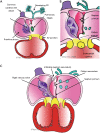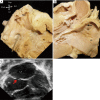Anatomy of the atrial septum and interatrial communications
- PMID: 30305943
- PMCID: PMC6174145
- DOI: 10.21037/jtd.2018.02.18
Anatomy of the atrial septum and interatrial communications
Abstract
Deficiencies in the septum separating the two atrial chambers are among the most common of congenital heart malformations. This article reviews the developmental aspects of the partitioning of the primitive atrium into right and left atrial chambers, the anatomical components of the atrial septum, and deficiencies that produce the various types of interatrial communications. Knowledge of the components of the true atrial septum in the developed heart clarifies the morphology of various types of interatrial communications. The oval fossa defect (also termed secundum ASD) is located within the true septum. The patent foramen ovale (PFO) is a tunnel-like passageway between the free edge of the overlapping ovale fossa valve and its muscular rim. Other defects such as superior and inferior sinus venosus defects, coronary sinus defects, and ostium primum defects lie outside the area of the true septum.
Keywords: Atrial septal defect (ASD); coronary sinus defect; patent foramen ovale (PFO); sinus venosus defect.
Conflict of interest statement
Conflicts of Interest: The authors have no conflicts of interest to declare.
Figures








Similar articles
-
Defining the morphologic phenotypes of atrial septal defects and interatrial communications.Images Paediatr Cardiol. 2003 Apr;5(2):1-24. Images Paediatr Cardiol. 2003. PMID: 22368625 Free PMC article.
-
Subxiphoid two-dimensional imaging of the interatrial septum in infants and neonates with congenital heart disease.Circulation. 1979 Jul;60(1):80-90. doi: 10.1161/01.cir.60.1.80. Circulation. 1979. PMID: 445736
-
Antiplatelet and Antithrombotic Therapy After Patent Foramen Oval and Atrial Septal Defect Closure.Curr Pharm Des. 2020;26(23):2769-2779. doi: 10.2174/1385272824999200427083838. Curr Pharm Des. 2020. PMID: 32338207 Review.
-
Anatomy of the true interatrial septum for transseptal access to the left atrium.Ann Anat. 2016 May;205:60-4. doi: 10.1016/j.aanat.2016.01.009. Epub 2016 Feb 12. Ann Anat. 2016. PMID: 26879344
-
The anatomy of interatrial communications--what does the interventionist need to know?Cardiol Young. 2000 Sep;10(5):464-73. doi: 10.1017/s1047951100008155. Cardiol Young. 2000. PMID: 11049122 Review.
Cited by
-
Modified approach for transcatheter correction of superior sinus venosus atrial septal defect: a case series.Eur Heart J Case Rep. 2023 Jan 17;7(1):ytad030. doi: 10.1093/ehjcr/ytad030. eCollection 2023 Jan. Eur Heart J Case Rep. 2023. PMID: 36727125 Free PMC article.
-
Zero-fluoroscopy transseptal puncture guided by right atrial electroanatomical mapping combined with intracardiac echocardiography: A single-center experience.Clin Cardiol. 2020 Sep;43(9):1009-1016. doi: 10.1002/clc.23401. Epub 2020 Jun 7. Clin Cardiol. 2020. PMID: 32506504 Free PMC article. Clinical Trial.
-
An Unusual Complication of Transseptal Puncture.JACC Case Rep. 2021 Jan 20;3(1):41-46. doi: 10.1016/j.jaccas.2020.11.038. eCollection 2021 Jan. JACC Case Rep. 2021. PMID: 34317466 Free PMC article.
-
Morphological Study of Fossa Ovalis in Formalin-Fixed Human Hearts and Its Clinical Importance.Medicina (Kaunas). 2021 Nov 16;57(11):1254. doi: 10.3390/medicina57111254. Medicina (Kaunas). 2021. PMID: 34833472 Free PMC article.
-
Morphological variations of the interatrial septum and potential implications in equine cardiology.Sci Rep. 2025 May 12;15(1):16500. doi: 10.1038/s41598-025-01387-3. Sci Rep. 2025. PMID: 40355652 Free PMC article.
References
-
- van der Linde D, Konings EE, Slager MA, et al. Birth prevalence of congenital heart disease worldwide. A systematic review and meta-analysis. J Am Coll Cardiol 2011;58:2241-7. - PubMed
Publication types
LinkOut - more resources
Full Text Sources
